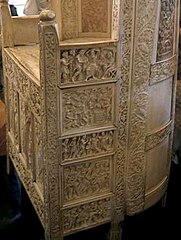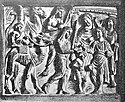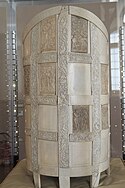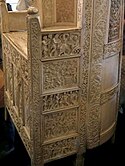Tron Maksymiana

Tron Maksymiana – tron z VI wieku z drewna i kości słoniowej wykonany dla arcybiskupa Maksymiana z Rawenny, obecnie wystawiany w Muzeum Arcybiskupim w Rawennie[1].
Historia
Tron datowany jest na lata około 546–556[1]. Uznaje się, że został on wyrzeźbiony na wschodzie Cesarstwa Bizantyjskiego i wysłany do Rawenny, ale od dawna toczy się naukowa debata na temat tego, czy został on wykonany w Konstantynopolu[1] czy w Aleksandrii[2]. Prawdopodobnie został zamówiony przez cesarza Justyniana i przesłany do Rawenny w darze arcybiskupowi Maksymianowi[1].
Opis
Tron ma 55,9 cm szerokości i 150 cm wysokości[1]. Styl tronu jest mieszanką sztuki wczesnochrześcijańskiej i bizantyjskiej. Wykonany jest z rzeźbionych paneli z kości słoniowej umieszczonych na drewnianym szkielecie[3]. Panele zawierają płaskorzeźby przedstawiające postacie i sceny biblijne. Różnice stylistyczne pomiędzy panelami sugerują, że zostały one wykonane przez kilku różnych artystów (być może nawet co najmniej czterech)[1]. Panele figuratywne są obramowane kompozycjami winorośli, ptaków i zwierząt[4]. Obecnie brakuje 12 paneli[4].
Na półokrągłym oparciu tronu umieszczono sceny z życia Jezusa i Maryi (pierwotnie 24 panele – 8 z przodu i 16 z tyłu), po bokach sceny z historii starotestamentowego Józefa (10 paneli), natomiast z przodu są czterej Ewangeliści i centralnie umieszczony św. Jan Chrzciciel, trzymający medalion z wyobrażeniem Baranka Bożego[1][2][5]. Z przodu tronu, poniżej paneli figuratywnych, znajduje się przedstawienie dwóch lwów strzegących wazy, z której wyrastają pędy winorośli, natomiast powyżej postaci świętych wyrzeźbiono monogram arcybiskupa Maksymiana[4] z pawiami po obu jego stronach [5].
Przypisy
- ↑ a b c d e f g Lawrence S. Cunningham, John J. Reich: Culture and values: A survey of the western humanities. T. 1. Wadsworth, 2010, s. 204-205. ISBN 978-0-495-57065-3. (ang.)
- ↑ a b Baldwin Smith. The alexandrian origin of the chair of Maximianus. „American Journal of Archaeology”. 21 (1), s. 22-37, 1917. DOI: 10.2307/497156 (ang.). [dostęp 2019-05-21].
- ↑ Benjamin Rowland: Byzantine (330-1453) (ang.). [dostęp 2019-05-21]. [zarchiwizowane z tego adresu (2017-10-14)].
- ↑ a b c Deborah Mauskopf Deliyannis: Ravenna in late antiquity: AD; 7. Ravenna capital: 600-850 AD. T. 1. Cambridge University Press, 2010, s. 214-222. ISBN 978-0-521-83672-2. (ang.)
- ↑ a b Maurice Hassett: Cathedra (ang.). The Catholic Encyclopedia. [dostęp 2019-05-21].
Media użyte na tej stronie
cátedra maximiano
catedra
Autor: GFreihalter, Licencja: CC BY-SA 3.0
Maximianskathedra im Erzbischöflichen Museum in Ravenna (Emilia-Romagna/Italien), Darstellung: Verwandlung von Wasser in Wein bei der Hochzeit zu Kana
Nativity (Throne of Maximianus in Ravenna)
catedra
cátedra
Autor: Internet Archive Book Images, Licencja: No restrictions
Identifier: monumentsofearly00lowr (find matches)
Title: Monuments of the early church
Year: 1901 (1900s)
Authors: Lowrie, Walter, 1868-1959
Subjects: Christian antiquities Christian art and symbolism Church architecture Church history -- Primitive and early church, ca. 30-600
Publisher: New York, The Macmillan Company London, MacMillan & Co.
Contributing Library: New York Public Library
Digitizing Sponsor: MSN
View Book Page: Book Viewer
About This Book: Catalog Entry
View All Images: All Images From Book
Click here to view book online to see this illustration in context in a browseable online version of this book.
Text Appearing Before Image:
Fig. 114.— Ivory cathedra of Maxiiniamis, bishop of Ravenna. About 550 a.d. John theBaptist and the four Evangelists, SCULPTURE — Ivo ries 287 the life of the Virgin show the influence of the apocryphal Gos-pels on early art, and present for the first time some of thesubjects which were to become popular in the Middle Ages.
Text Appearing After Image:
mm ivi ^ ^r Fig. 115.-The story of Joseph; example of carving on the back of the cathedra of Maximianus. On the sides the story of Joseph is related in ten scenes. Twoof them are illustrated in Fig. 115: in the lower scene Josephis let down into the well while his brothers stain his coat withblood; above, Jacob tears his hair at the sight of Josephs 288 nCTORlAL ART bloody coat. These figures show great rudeness of execution,but at the same time a certain barbarous vigor which looksmore like the forceful beginnings of a new art than the de- F^^ m ^^KlUK- ,.ijlipU;ijl;^lU W^^ Fk;. 11(1.- I\niy (iu-prl i.ivri- Ildiii Miiriiiu), now at Ravenna. -i\il; ir seventh century.Christ enihrDiuMl auiidst the Apostles, the Three Children iu the luniace, the story ofJonah, the healing of the blind, the raising of Lazarus, healing of a demoniac, healing ofthe paralytic. cadence of an old. They suggest the reflection that manyhopeful revivals of art must have been rendered abortive bythe frequent sup
Note About Images
catedra
catedra
catedra
catedra
Autor: GFreihalter, Licencja: CC BY-SA 3.0
Maximianskathedra im Erzbischöflichen Museum in Ravenna (Emilia-Romagna/Italien)
catedra






























